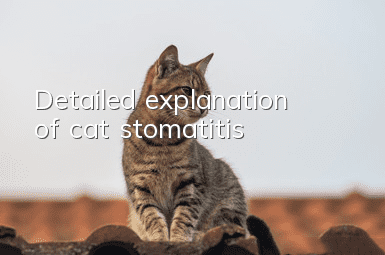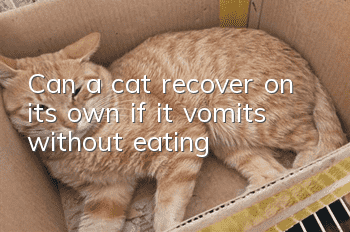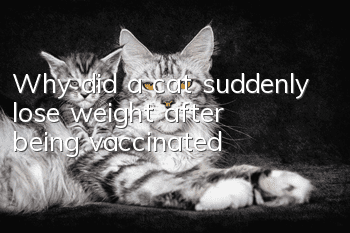Detailed explanation of cat stomatitis

Stomatitis is a very serious and painful disease, which is an infection of the mouth and gum tissue.
Today I will take you to learn more about feline stomatitis.
01. Causes of stomatitis
The exact cause of stomatitis is not yet known, but there are several possible factors, which I have listed below.
1. Dental disease
Dental disease, especially periodontitis, is often cited by some veterinarians as the primary cause of stomatitis. Dental diseases are basically caused by dental plaque and calculus. However, tooth resorption is an exception.
2. Weak immune system Some people believe that stomatitis is caused by abnormalities in the cat’s immune system. An abnormal immune system will give incorrect feedback to the bacteria in the oral cavity and attack its own healthy oral tissues, leading to stomatitis.
3. Other infections
Feline leukemia - FeLV
Feline AIDS - FIV
Calicivirus (feline calicivirus)
Bartonella - associated with cat-scratch disease and cat-scratch fever
02. Which varieties are high risk
Stomatitis is a common problem in feline diagnosis and treatment. Cats of all ages, all breeds, and all mixed breeds can be affected. Some breeds seem to be statistically more susceptible to stomatitis.
This includes:
Himalayan cat
Persian cat
Exotic short
Siam
Maine
Somalia
Abby
Dongduan
03. Symptoms of stomatitis
Cats suffering from stomatitis may show one or a combination of the symptoms listed below.
These symptoms include:
Bad breath
Gingivitis
Oral ulcers include lips, tongue, gums and back of throat
Tooth resorption
Drooling
Difficulty eating and swallowing
Refusing to eat, barking when food is touched, unable to pick it up
Can scratch face or mouth with claws
Weight loss
I have unruly hair. Because of the pain, I comb myself less often
04. What does stomatitis look like
First of all, we should not confuse stomatitis with gingivitis. Gingivitis can be understood as an early symptom of periodontitis.
Stomatitis refers to a wider scope: including inflammation of the entire oral mucosa, which can extend to the gums, tongue, inside and outside of the lips, and the upper and lower jaws.
The picture below shows the mouth of a cat with gingivitis:
From the picture below, we can see that in cats with gingivitis, the periodontal tissue surrounding the teeth has become inflamed and red:
The picture below shows a cat suffering from stomatitis. We can see that the area of inflammation in the oral mucosal tissue is very extensive:
In the picture below, the cat’s stomatitis is more serious, with lesions on the gums, tongue and inside of the lips:
Severe stomatitis can spread to the upper and lower jaw and may spread to the throat:
Stomatitis can also cause tooth resorption, as shown below:
05. Diagnosis of stomatitis
Preliminary diagnosis: A simple inspection, an experienced veterinarian will give you a rough idea. If you carefully observe the case pictures above, you will be able to self-diagnose at home.
Stomatitis is a chronic disease that gradually spreads to various tissues in the oral cavity.
Oral inflammation in a short period of time may be the beginning of stomatitis. Of course, it may not be stomatitis but another disease entirely. If the inflammation in the mouth does not spread widely but is localized to a specific area.
Then the possible causes may be as follows, so don’t misdiagnose:
Allergy
Foreign body
Periodontal disease or other dental problems
Tooth resorption
Further diagnosis: Many veterinarians may ask you to do blood routine and biochemistry on your cat, but this is of no use for stomatitis.
It is not as practical as the following inspection items:
Basic disease examination mainly includes leukemia, feline AIDS, cup body, and Bartonella
Tissue biopsy can distinguish stomatitis and oral cancer
Tooth resorption can be observed on X-ray
06. Initial treatment of stomatitis
The impact of stomatitis on cats mainly depends on the stage and severity of stomatitis and the degree of pain the cat endures.
Drugs and surgery can be combined treatments.
Stomatitis is generally very painful, so initial treatment options usually include:
Pain relief
Anti-inflammatory
Anti-infection
Liquid food aid
Supplements to enhance immunity
Concurrent treatment of other underlying diseases
07. Long-term treatment plan
Medication treatment is effective in the short term and can relieve symptoms, but the long-term effect is worrying and even disappointing.
Generally speaking, surgical treatment is the fundamental solution.
These plans include:
Teeth cleaning
Remove premolars and molars
Whole tooth extraction
The specific implementation plan should be discussed in detail with the doctor and the pros and cons should be weighed.
08. Prognosis
Feedback on treatment effectiveness is mixed.
Some cats need to take long-term anti-inflammatory drugs, supplemented by intermittent antibiotics, to control the disease. There are also cases where treatment is ineffective. In this case, the cat's life will be endangered.
Continuous pain will cause the cat to be unwilling to eat, and euthanasia may be the only option.
- How to tell if a cat has a fever without a thermometer
- Causes and treatments of pet cat ear scabies
- Do cats need additional nutritional supplements besides eating cat food? The nutrients cats need every day!
- How to make a cat remember its name and learn to shake hands
- At what age can a cat be dewormed? Teach you step by step how to raise a cat and deworm it!
- Why cats don’t like to be hugged
- What should I do if my cat is frightened and stressed by the hair dryer while taking a bath?
- How to tell if a cat is throwing up hairballs or vomiting
- How to trim a cat's nails
- Your cat’s vision seems to have declined? Be careful when petting your cat!



